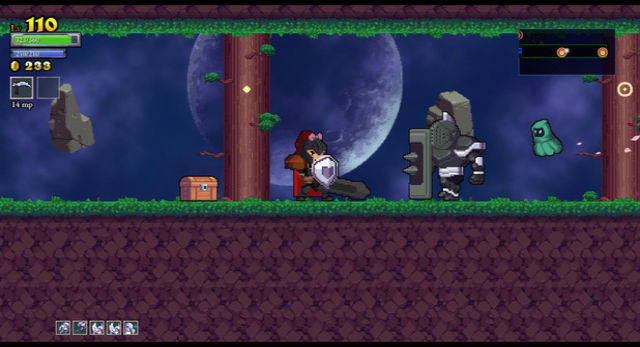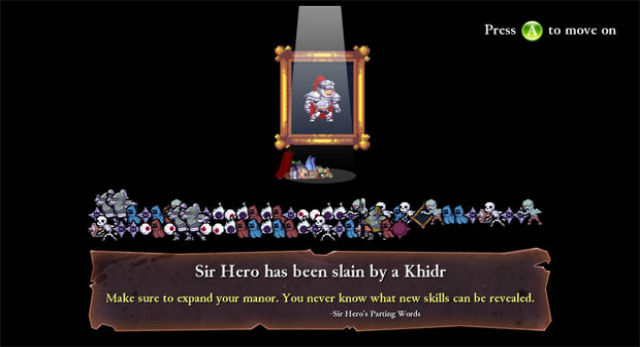As a fan of old-school adventure games and dungeon crawlers such as Castlevania: Symphony of the Night and The Legend of Zelda: Link’s Awakening, I was naturally intrigued when I first heard of Rogue Legacy, a new title from developer Cellar Door Games which sought to honor the sprite-based dungeon-crawling roguelike formula of old while also adding innovative and often humorous new additions such as procedurally generated environments and randomized character traits. Like many past roguelike games, Rogue Legacy is far from easy yet its clever use of art assets and quirky gameplay mechanics makes it hard for players not to get sucked in despite the fact that their hero will die many, many times over the course of a typical playthrough.
On paper, Rogue Legacy’s premise sounds rather simple: players must pick a hero before venturing into a foreboding castle, slaying monsters and gathering treasure as they seek to unravel the mystery behind the castle’s origins. If the player’s hero dies (and they most assuredly will), that hero’s heir will take their place and so on and so forth. Each hero and heir can be one of nine different classes, each with their own signature traits and skills, and each hero or heir is also saddled with a randomized physical trait which can either help or hinder them on their adventures.
These randomized traits combined with the procedurally generated rooms of the castle which change during every new playthrough are what make Rogue Legacy truly unique and ensure that every new adventure feels fresh. Some traits, such as hypergonadism (being able to knock enemies back further with your attacks) or O.C.D. (magic points are recovered whenever the player breaks an object in the castle), can help the player while others, such as being near-sighted (edges of the screen are blurry) or having vertigo (the screen get’s flipped upside down), naturally make it all that much harder. Then there are some like nostalgia (the screen gets a grainy sepia overlay) or stereo-blind (both the hero and enemies become 2D sprites ala Paper Mario) that are purely cosmetic yet still add to the game’s charming atmosphere.
In true roguelike fashion, none of the traits are ever really explained within the game itself and are instead given vague yet often humorous descriptions (for instance the “baldness” trait, which simply removes the feathered plumage from the hero’s helmet, reads as “the bald and the beautiful”) through which the player must figure out just how exactly they affect the hero. Even the various items that players can acquire while venturing through the castle lack a formal description, again, forcing players to find out first-hand whether they’re helpful or a hindrance (for instance, the “Hedgehog’s Curse” item, in a clever little nod to a certain blue hedgehog, causes a portion of the gold coins the player has managed to collect to fly out into the environment whenever the hero is struck by an enemy or trap).
Despite Rogue Legacy’s punishing difficulty, its randomized and humorous nature combined with its artistic old-school aesthetic creates a solid gameplay balance that is challenging without being frustrating, visually appealing without having to rely on cutting-edge graphics or particle effects. The game’s progression system, which allows the player to use the gold they’ve amassed to buy new weapons and armor and even upgrade their hero’s home manor to acquire permanent stat boosts, ensures that Rogue Legacy’s steep difficulty curve will eventually taper off (yet never to the point of trivializing the game’s large roster of enemies and monsters) while its purposefully vague narrative (which includes five intense boss fights spread out over the course of the game) helps keep more story-driven players motivated.
Even without its story and progression I still found Rogue Legacy to be (the “glaucoma” trait, for instance, shrouds the area around the hero in permanent darkness, obscuring the player’s peripheral vision while the “dwarfism” and “gigantism” traits either decrease or increase the hero’s size and hit box). The game’s difficulty can make gathering enough gold for upgrades during the first few hours a taxing experience but once you manage to immerse yourself in the game’s charming yet deadly premise, you begin to understand why you just can’t put the controller down even after watching the “Your Hero Died” screen pop up countless times.
There is no one element that makes Rogue Legacy such a solid game. Story, progression, RPG elements, randomized traits and room layouts, cheeky humor, challenging gameplay, charming and colorful art assets, Cellar Door Games manages to bring them all together in a way that both honors the lineage of roguelike games that came before (hence the title “Rogue Legacy”) and brings new fans into the fold. I think it’s a strong testament to Rogue Legacy’s success that, despite my usual lack of fondness for difficult games, I played through much of Cellar Door’s new roguelike adventure with a smile on my face.




 …WOOLY DESERVES BETTER LOL!
…WOOLY DESERVES BETTER LOL!